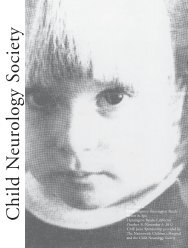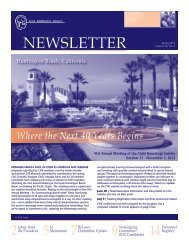to download the document - Child Neurology Society
to download the document - Child Neurology Society
to download the document - Child Neurology Society
Create successful ePaper yourself
Turn your PDF publications into a flip-book with our unique Google optimized e-Paper software.
Cns AnnUAl meetInG<br />
Award Profiles<br />
The Arnold P. Gold<br />
Humanism in Medicine Award<br />
MARvIN FISHMAN, MD<br />
MARvIN FISHMAN, MD<br />
(Presented Saturday, November 3)<br />
Profile wriTTeN by roberT S. ruST, MD<br />
Marvin Fishman was born in Chicago, Illinois on<br />
February 16, 1937. he attended Chicago public<br />
schools. his interest in medicine was aroused<br />
by his admiration for his own pediatrician.<br />
he attended college and medical school at<br />
<strong>the</strong> University of Illinois from which he was<br />
awarded his M.D. degree in 1961. Exposure <strong>to</strong><br />
neuroscience while in medical school influenced<br />
Dr. Fishman’s decision <strong>to</strong> become a neurologist.<br />
his first original publications, concerning<br />
neuropharmacology, were published during his<br />
senior year in medical school. During medical<br />
school he met and married his wife of more<br />
than half a century, Gloria Greenberg. They<br />
started a family that includes two children,<br />
Bradley Stephen and Patricia Ann. Dr. Fishman<br />
completed his internship and pediatric residency<br />
at Michael Reece hospital in Chicago in 1964<br />
followed by two years service as a captain and<br />
Chief, Pediatric Outpatient Clinic in <strong>the</strong> U.S.<br />
Army Medical Corps at William Beaumont<br />
General hospital in El Paso, Texas. his training in<br />
neurology and child neurology started in 1966<br />
at <strong>the</strong> Massachusetts General hospital under Phil<br />
Dodge, who became for him as for many o<strong>the</strong>rs,<br />
“<strong>the</strong>” role model. he completed his training<br />
at St. Louis <strong>Child</strong>ren’s hospital having been<br />
part of <strong>the</strong> remarkable transplantation of <strong>the</strong><br />
Dodge group <strong>to</strong> St. Louis, a group that included<br />
Art Prensky, joe Volpe, and Darryl DeVivo. Art<br />
Prensky and harish Agrawal served as men<strong>to</strong>rs<br />
for Dr. Fishman’s development as a neurochemist<br />
specializing in developmental lipid chemistry.<br />
In addition <strong>to</strong> <strong>the</strong> knowledge that all of <strong>the</strong>se<br />
individuals imparted, <strong>the</strong>y provided an example<br />
of <strong>the</strong> remarkable work ethic that has been<br />
characteristic of Dr. Fishman’s career as well.<br />
At Washing<strong>to</strong>n University, Dr. Fishman was <strong>to</strong><br />
become a pioneer in <strong>the</strong> new field of pediatric<br />
neurorehabilitation. he became Co-Direc<strong>to</strong>r<br />
of <strong>the</strong> birth defects program at St. Louis<br />
<strong>Child</strong>ren’s hospital and from 1973-1979 he was<br />
Direc<strong>to</strong>r of <strong>the</strong> Irene Walter johnson Institute<br />
of Rehabilitation at Washing<strong>to</strong>n University.<br />
he participated as well in patient care in <strong>the</strong><br />
ophthalmology and o<strong>to</strong>laryngology programs as<br />
well as <strong>the</strong> intensive care services in which Drs.<br />
Volpe, Prensky, DeVivo, and Ed Dodson were<br />
also engaged. Dr. Fishman established a steady<br />
record of scholarly publication that engaged<br />
and refined <strong>the</strong> talents of <strong>the</strong> many individuals<br />
whom he encountered and men<strong>to</strong>red during<br />
<strong>the</strong>ir training in child neurology, first at Wash<br />
U and subsequently at Baylor. Over <strong>the</strong> course<br />
of his career Dr. Fishman has thus produced 62<br />
original full-length publications covering such<br />
<strong>to</strong>pics as development of cerebral myelin and<br />
effects on this of malnutrition (11 papers), o<strong>the</strong>r<br />
neurochemical disorders (2), congenital brain<br />
developmental abnormalities (15), neonatal,<br />
cardiovascular, and critical care aspects of brain<br />
injury (11), infectious CNS illnesses (7), and a host<br />
of o<strong>the</strong>r subjects. Dr. Fishman has served on <strong>the</strong><br />
edi<strong>to</strong>rial boards of <strong>the</strong> journal of Pediatrics, <strong>the</strong><br />
journal of <strong>Child</strong> <strong>Neurology</strong>, Pediatric <strong>Neurology</strong>,<br />
and Annals of <strong>Neurology</strong>.<br />
One particular driving force in Dr. Fishman’s keen<br />
interest in child neurology and neuroscience –<br />
one that he shared o<strong>the</strong>r early child neurologists<br />
and continues <strong>to</strong> share with those that have come<br />
after – is <strong>the</strong> sense of urgency <strong>to</strong> fill in <strong>the</strong> details<br />
of those subjects about which we have known<br />
little, details about which few pediatricians or<br />
o<strong>the</strong>rs have <strong>the</strong> curiosity <strong>to</strong> even notice, much<br />
less investigate. To describe this as a “driving<br />
force” might seem paradoxical in an individual<br />
of such sustained gentlemanly calmness and<br />
composure. It is none<strong>the</strong>less true that this has<br />
been a force of extraordinary and exceedingly<br />
productive energy. his career has been one that<br />
has devoted itself <strong>to</strong> enlarging that knowledge<br />
and thus improving <strong>the</strong> quality of care that<br />
is made available <strong>to</strong> children with neurologic<br />
diseases. Among o<strong>the</strong>r early achievements<br />
he described <strong>the</strong> neurocutaneous condition<br />
technically termed encephalocraniocutaneous<br />
lipoma<strong>to</strong>sis that has subsequently also been less<br />
challengingly termed “Fishman’s syndrome.”<br />
Dr. Fishman rose through <strong>the</strong> ranks in St. Louis,<br />
achieving professorships in Pediatrics, <strong>Neurology</strong><br />
and Preventative Medicine at Washing<strong>to</strong>n<br />
14 <strong>Child</strong> <strong>Neurology</strong> <strong>Society</strong> Newsletter | Fall 2012




